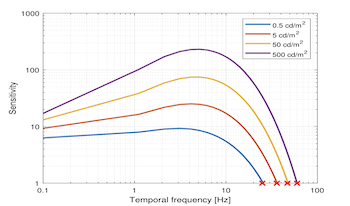
Contrast sensitivity functions (CSFs), which provide estimations of detection thresholds, have far-reaching applications in digital media processing, rendering, and transmission. There is a practical interest in obtaining accurate estimations of spatial and temporal resolution limits from a spatiotemporal CSF model. However, current spatiotemporal CSFs are inaccurate when predicting high-frequency limits such as critical flicker frequency (CFF). To address this problem, we modified two spatiotemporal CSFs, namely Barten’s CSF and stelaCSF, to better account for the contrast sensitivity at high temporal frequencies, both in the fovea and eccentricity. We trained these models using 15 datasets of spatial and temporal contrast sensitivity measurements from the literature. Our modifications account for two features observed in CFF measurement: the increase of CFF at medium eccentricities (of about 15 deg), and the saturation of CFF at high luminance values. As a result, the prediction errors for CFF obtained from the modified models improved remarkably.

We have developed an assistive technology for people with vision disabilities of central field loss (CFL) and low contrast sensitivity (LCS). Our technology includes a pair of holographic AR glasses with enhanced image magnification and contrast, for example, highlighting objects, and detecting signs, and words. In contrast to prevailing AR technologies which project either mixed reality objects or virtual objects to the glasses, Our solution fuses real-time sensory information and enhances images from reality. The AR glasses technology has two advantages: it’s relatively ‘fail-safe.” If the battery dies or the processor crashes, the glasses can still function because it is transparent. The AR glasses can also be transformed into a VR or AR simulator when it overlays virtual objects such as pedestrians or vehicles onto the glasses for simulation. The real-time visual enhancement and alert information are overlaid on the transparent glasses. The visual enhancement modules include zooming, Fourier filters, contrast enhancement, and contour overlay. Our preliminary tests with low-vision patients show that the AR glass indeed improved patients' vision and mobility, for example, from 20/80 to 20/25 or 20/30.